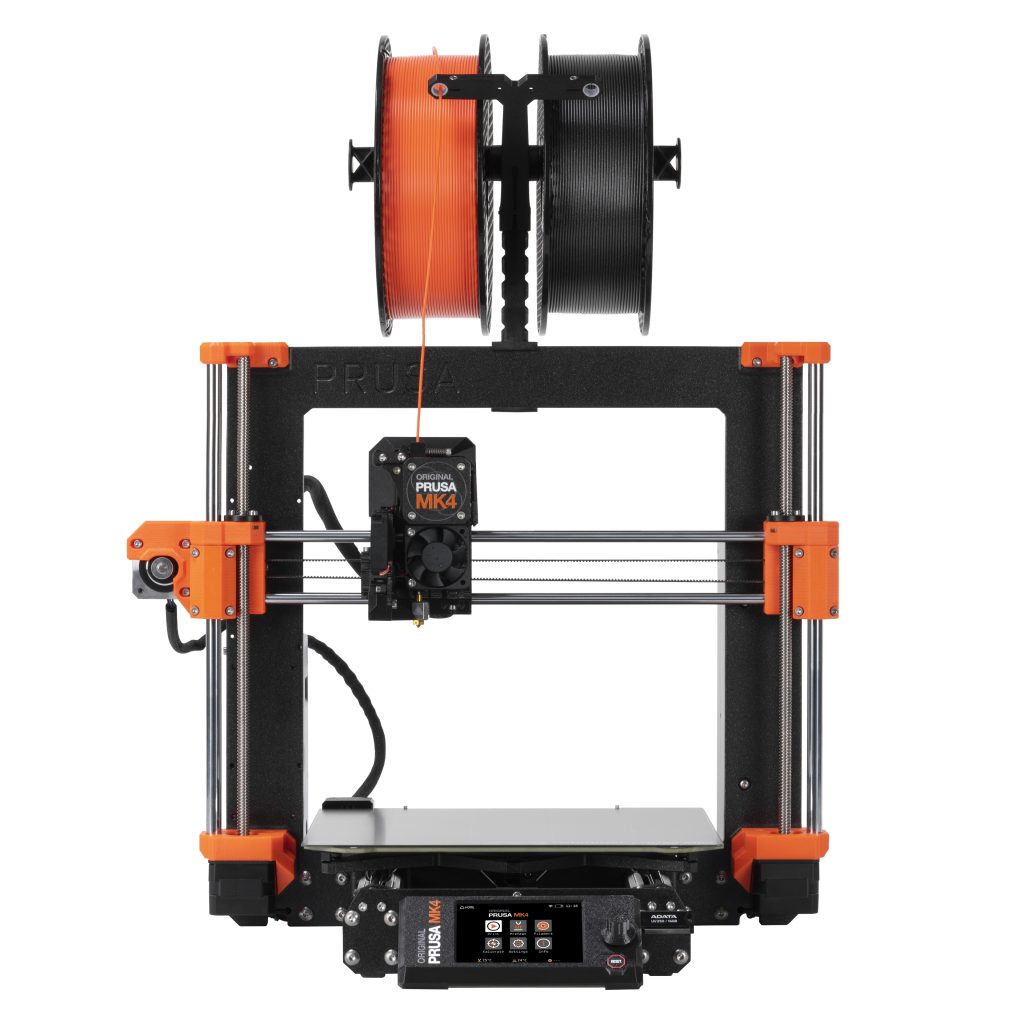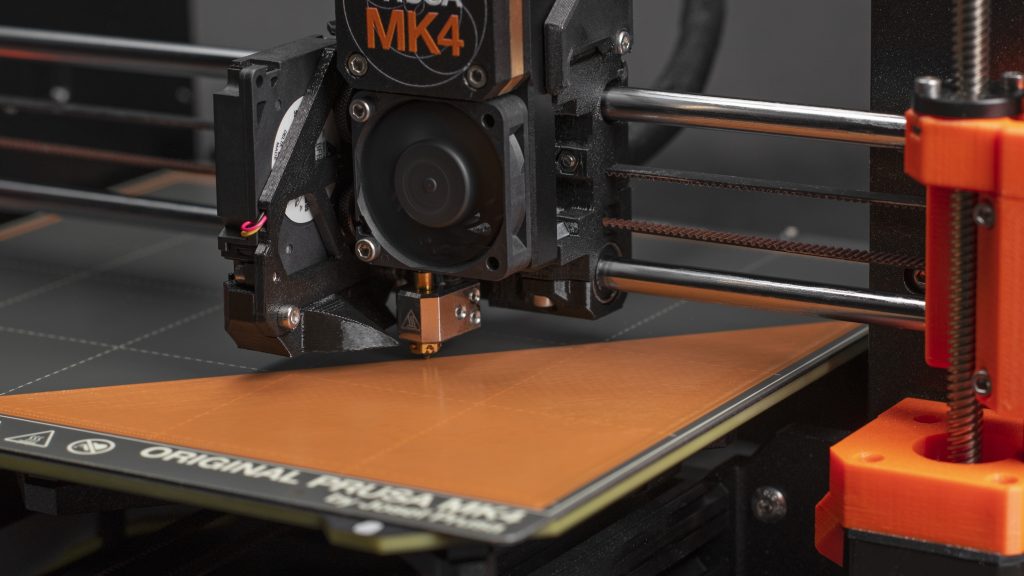Czech based 3D printer manufacturer Prusa Research have announced their new desktop 3D printer, the Original Prusa MK4. This new machine follows the success of its predecessor, the MK3, which has sold over 350,000 units worldwide over the past five years, and won four consecutive 3D Printing Industry “3D printer of the year” awards between 2019-2022.
Whilst Prusa has built on the proven concept of the MK3, the company is keen to highlight the various improvements incorporated into its new printer. “It might look similar at first glance, however, in fact, we adjusted, improved, or outright replaced 90% of the parts”, commented Prusa Research founder and CEO Josef Prusa.
A key aim for this printer is improved user experience, with multiple new features aimed at making the printing process quicker, easier, and more intuitive, enabling broader printing possibilities for makers of all experience levels. Josef Prusa calls the MK4 “another step towards making the 3D printer technology more accessible for regular users, which are not interested in tweaking and tinkering with the printer – they just want to print.” The MK4 is available to order now, with more information available on the Prusa Research website.
Key features of the MK4:
The MK4 incorporates Prusa’s new xBuddy board, a 32-bit STM32-powered mainboard which replaces the old EINSY RAMBo board used by the MK3. Called the “cornerstone” of the MK4, this new mainboard has been designed, manufactured, and tested in-house at Prusa.
Designed to maximize safety and reliability, the xBuddy offers multiple new features over its predecessor. For instance, the board incorporates dual voltage measuring, heater current measurements and total input current measurement on the 24V branch. Moreover, to maximize printer safety, the board automatically disconnects the hotend heater if the current exceeds 2.8A, whilst also disconnecting the heater and heatbed power supply when the total current surpasses 15A. The board also provides power outage recovery, and includes four thermistors (hotend, heatbreak, heatbed, and ambient).
Featuring TMC2130-LA drivers, xBuddy is also equipped with numerous ports, including an ESP-01 Wi-Fi port, ethernet port, service USB-c port, 12C port, accelerometer port (unpopulated), Multi Material Upgrade 3 (MMU3) port, and a Nextruder port.

Prusa’s next generation extruder, the Nextruder, is another key addition to the MK4. A smaller, lighter version of the Nextruder already utilized on the Original Prusa XL, MK4’s Nextruder possesses the same Load cell sensor as its larger counterpart. This sensor accurately sets the distance between the nozzle and the print sheet by measuring the tension inside the extruder. This process allows the MK4 to automatically print a perfect first layer straight out of the box, eliminating the need for Live Adjust Z or any manual nozzle adjustments.
The Nextruder port on the mainboard also offers notable benefits for the user. Previous Prusa models connect extruder components directly to the mainboard, making the replacement of certain extruder components a complicated and time consuming process. However, the MK4 incorporates a new connector break-out board, the ‘LoveBoard’, which directly connects all extruder components inside the Nextruder. This feature significantly speeds up the replacement process for extruder components.
The MK4’s new quick-swap nozzle has also been designed to save the user time when making hotend alterations. Thumb screws have been added either side of the Nextruder which, when loosened, allow the entire hotend to be removed and replaced quickly and easily. Once alterations have been made, the Load cell sensor provides quick and automatic calibration at the beginning of the next print. Prusa also offers a Nextruder-to-V6 adapter which enables any v6-compatible nozzle, including hardened and high flow models, to be used with the MK4. Equally, the company has also released a range of nozzles (from 0.25 to 0.8) which are available in their e-shop, with more models expected to be added in the future.

High print speed is another key feature of the MK4, with the printer incorporating Input Shaper and Pressure Advance, two technologies which can decrease print times by up to 75% while retaining good print quality. For instance, as is shown in the demonstration video below, a sample print that would take 80 minutes on the MK3, can now be completed in under 20 minutes.
A new graphic LCD interface has also been added to the new MK4, replacing the old segmented LCD of previous models. This color LCD screen can support G-code thumbnails, longer texts, graphics and QR codes. Moreover, an RGB status bar has also been added below the LCD screen, with a programmable set of RGB LEDs using various colors to indicate the current state of the printer. A USB-A port has also been added next to the display, allowing the user to use a USB flash drive to store G-Codes.
Alongside the release of the MK4, Prusa has also announced the new Multi-Material Upgrade 3 (MMU3), which is compatible with both MK3S+ and MK4 models. This optional add-on allows the single extruder printer to print with up to 5 colors at a time, with the MMU3 offering improved reliability and easier controls than previous versions. Available to order from the Prusa e-shop, the MMU3 is expected to start shipping in June of this year.

Technical specifications and pricing:
Prices for the Original Prusa MK4 start at $799 USD for the assembly kit, and $1099 for the fully assembled printer. Customers can also purchase upgrade packages for their existing MK3S+ models, including MK3.5, MK3.9 and MK4 upgrade options.
| Build volume | 250 x 210 x 220 mm | 9.84 x 8.3 x 8.6 in |
| Layer height | 0.05-0.30 mm |
| Max hotend/heatbed temp. | 300℃ / 120℃ (572℉ / 284℉) |
| Mainboard | Custom 32-bit xBuddy electronics with STM32 |
| Stepper Drivers | Trinamic 2130 silent stepper drivers |
| Stepper Motors | 400 steps (prevents VFA) |
| Extruder electronics | Custom breakout board for connecting fans, thermistors and other parts |
| Filament path | Aluminum heatsink, all-metal hotend, no PTFE tube |
| Drive system | Planetary Gear System, 1:10 gearbox sensor |
| Nozzle diameter | 0.4mm (default) / other nozzle diameters supported |
| LCD screen | 3.5” graphic 65k color screen |
| Print surface | Magnetic heatbed with removable PEI spring steel sheets |
| Bed calibration | Automatic, Mesh Bed Leveling (only on print area) |
| Supported materials | Any thermoplastic including Nylon and Polycarbonate |
| Wi-Fi connection | Optional ESP Wi-Fi module (delivered with printer) |
| Advanced sensors | 4 high-precision thermistors (genuine Semitec) + fan motors RPM monitoring |
| Print medium | USB drive / LAN / internet via Prusa Connect |
| Firmware update interface | USB drive |
| Power supply | 240W, custom made by Delta with Power Panic HW |
Subscribe to the 3D Printing Industry newsletter to ensure you keep up with the latest 3D printing news. You can also follow us on Twitter, like our Facebook page, and subscribe to the 3D Printing Industry Youtube channel to access more exclusive content.
Are you interested in working in the additive manufacturing industry? Visit 3D Printing Jobs to view a selection of available roles and kickstart your career.
Featured image shows the Original Prusa MK4 in action. Photo via Prusa Research.


